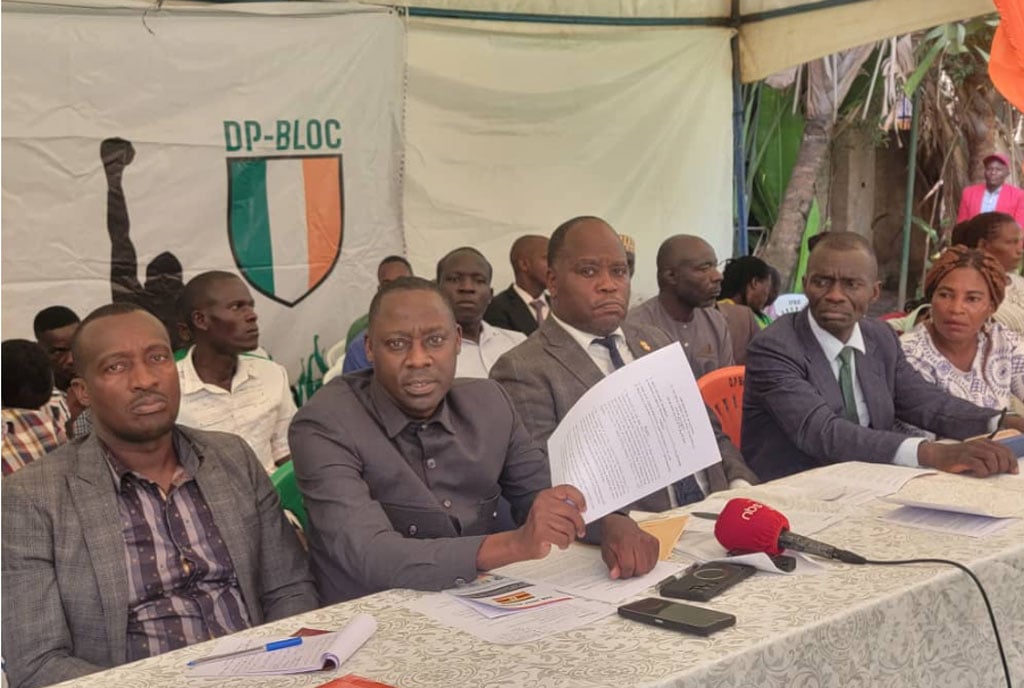Prime
Survival of Nakiyima, Ekyabagabe tree shrines

Offerings. The faithful with their gifts that they have come to offer to the gods at the Ekyabagabe Tree Shrine in Ntungamo District, recently. Photos by Bamuturaki Musinguzi
What you need to know:
Spiritual world. Nakayima and Ekyabagabe tree shrines have survived centuries after the disintegration of the powerful Bacwezi Dynasty. They represent places where communication links with the spiritual world are maintained, Bamuturaki Musinguzi, writes.
On a late sunny afternoon, pilgrims of all ages are praying in whispers, chanting, singing, drumming, ululating, clapping or speaking in tongues, while others appear to be in a trance as they shake their heads under the shade of the giant Ekyabagabe tree in Ngoma Sub-county, Ntungamo District.
Some are kneeling on the ground, while others are seated on mats or on the huge roots of the famous big tree.
A man climbs up the tree and settles on a lower branch where he quickly performs dance moves similar to the ekitaguriro – a traditional dance from Ankole.
A small herd of sheep and a dog have escaped from the hot sun and are resting in the shade under the tree.
The land on which the tree stands belongs to the community and is used for communal grazing.
There is an ever burning sacred fireplace (ekyooto) fueled by cow dung at the entrance of the shrine. Any of the pilgrims can light up the fire by adding more cow dung.
The Ekyabagabe tree shrine, that occupies about 70 square feet, has big gnarled roots that separate the entrances into seven sections. The roots spread more than 50 metres away from the main tree.
The tree trunk has three big sides with extensive leafy branches. In one of the entrances in the tree trunk, a kerosene lantern is lit whenever there is someone praying either during the day or night. The faithful believe that God works in the light.
The priest stores the gifts that the believers bring in one of the trunks. The gifts include money, cows, sheep, goats and bananas, among others.
Whoever arrives at the shrine for prayers and healing has to remove their shoes from the eastern side of the tree. They then proceeds to make a wish, sit to pray, present thanks and move around the tree through the south by visiting the three ‘rooms’ of the tree.
The pilgrims are diverse and have come to pray for blessings, peace in their homes, love, harmony, fortune and prosperity.
Preaching in Runyankole, a man who claims to be the priest of the high place wonders why children are longer sharing meals with their parents. Why are children failing to attend school? Why are there fights over land and property in families? He reminds the worshippers that the Bacwezi can foretell what will happen in future including thunder.
Saturday Monitor learns that the faithful spend days and weeks here for prayer and healing. They believe that healing happens at night because that is when God listens to every prayer they make.
During the day, their minds wander and they do not concentrate on God and even when they pray, they may fail themselves.
Politicians have allegedly gotten into offices after praying at the tree, the barren have given birth, the unemployed have gotten jobs, and the businessmen and women have prospered.
The pilgrims are not allowed to reveal their names or use cameras at the shrine. But Faith Mushabe and her daughter Noume Kemirembe agree to reveal their names and share their testimonies.
“I came here yesterday to thank God because when I prayed here for a child I got a baby girl (Queen Nabasa), who is two years old now,” Kemirembe tells Saturday Monitor.
“I had spent five years without conceiving. I came with my husband and we prayed together. The time that you spend here depends on God’s revelation to you. The revelation may even take a month before you leave,” Kemirembe adds.
“We take our meals at a nearby restaurant. We are protected by the police who are aware of our presence here,” she reveals.
“I have been praying here for five years now. I always go back home in Kooki, Rakai District, to check on my family. I first came here to pray for Noume when she fell ill at school during her Senior Three and she got healed. Her in-laws were nonbelievers, they had bewitched her to fail in school and die before marriage. We prayed and God blessed us, we are now peaceful,” Mushabe says.
Mushabe adds: “We spend nights here under God’s protection. The cold winds in the night have healing powers. Our offerings are about helping fellow worshippers. The offerings are out of our own free will, which makes a difference from those made in church. We call the offerings ekigabiro. If you come with good intentions, you will be blessed.”
Robert Aturinda, the Ntungamo District tourism officer, says: “That tree has publicised our district as a unique feature among our tourism attractions. People come from as far as Rwanda, Burundi, Tanzania and DR Congo to worship and we believe they get what they want.”
“It is one of our tourism products that we want to preserve and promote. This includes the possibility of acquiring the land on which the tree sits and turn it into a national site. There are very few people who know that such sites exist,” he adds.

The Ekyabagabe tree is located 45kms from Ntungamo Town, less than 600 metres from the Uganda-Rwanda border post at Mirama Hills.
Ntungamo District is about 370Km west of Kampala. Most people in the locality speak Kinyarwanda.
During the Bacwezi Dynasty, the Ekyabagabe tree was a place of high regard, where healing and power were believed to come from.
In the recent past, the Kingdom of Rwanda would install the Kigeri (King) at the tree before performing other rituals at Lake Kiyanja, 15Km away, also in Ngoma.
The Nakayima Tree Shrine
When we arrive at the Nakayima Tree Shrine on Mubende Hill, it is a beehive of activity as pilgrims are consulting the priest, praying, singing, making offerings, smoking pipes, eating fresh fruits.
People in the kitchen are mingling posho (maize meal), children are playing, while Ddungu’s hunting dogs are moving about or eating leftovers.
There are three sacred ever burning fireplaces at different corners for Ddungu (god of the hunters); Bamweyena (god for prosperity); Kiwanuka (god of war and army commander) and Kalisa (the cattle keeper).
Kalisa’s fireplace is kept burning with cow dung by a pilgrim, who has had a dream from Kalisa directing him or her to do so. The burning fireplaces symbolise the presence of the powers of the Bacwezi.
The Nakayima Tree Shrine, also known as Embuga ya Nakayima e Mubende, sits on 10 acres. The religious traditional shrine is located more than 3kms from Mubende Town and about 172kms west of Kampala.
The Mubende Hill is 700 feet tall, with a flat tabletop where King Ndahura’s ancient palace once stood. The strategic hill provides an excellent view of Mubende Town and the surrounding areas.
The indigenous forest tree known as mukoko in the Runyoro-Rutoro language or the scientific name Pterygota mildbraedii (sterculiaceae) is estimated to be between 350 and 400 years old.
The Ministry of Culture Community Development says: “It is probable that it (tree) formed part of the fence which surrounded Ndahura’s palace and because of its survival, it was ritualised. Ndahura’s spirit was thought to dwell in the tree from where it would come to possess Nyakahuma…”
The pilgrims have come to pray and pay homage to the matriarch Nakayima of the Bacwezi Dynasty. Legend has it that the Bacwezi were demi-gods with supernatural powers.
The faithful claim that Nakayima appears to them through dreams dressed in white clothes with instructions on what to do to overcome their problems and have wishes fulfilled.
Other gods
Ddungu, Kiwanuka and Kalisa also reveal themselves through dreams. The believers only leave after the gods have appeared to them and this could happen between three days and a month.
It is believed that the Bacwezi spirits disappeared in this tree and, therefore, are not cut or used for cooking or any other purpose. The branches that fall are left to rot. The faithful fear being punished by the Bacwezi spirits that disappeared in the trees, water and hills.
Pilgrims with important wishes bring presents and offerings in form of money, one liter of fresh milk, tobacco, coffee beans, chicken, sheep, goats, cows, ghee, millet, sorghum and sim sim. The presents and offerings are placed in particular rooms under the big tree, while the millet, sorghum and sim sim are broadcast around the tree.
One can only bring particular food that he or she was asked to carry in the dream by the spirits. And the food is only prepared in Nabuzana’s kitchen and shared with other pilgrims.
“I have been coming here for the last three years to worship Nakayima. When we come, we pray for peace in our homes, prosperity and healing from different illnesses,” Stanely Kiwanuka Bukenya, 30, tells Saturday Monitor.
Bukenya hails from Masaka District and lives in Makindye in Kampala City. “I have spent here three days and I will be leaving today to visit my relatives in Kibaale District,” he reveals.
“If someone is ill or has challenges such as poverty, lack of a job, wife or husband, they come here and light the fires while pronouncing their wishes. Besides, you can also befriend good people here,” he says.
“The first time I came here, I was trading in coffee but not making profits. When I prayed, the customers increased, I now grow coffee on three acres. With an increased income, I have managed to build a house in my village Masaka and another in Kampala where I live with my family. My family members also no longer get sick.”
Rose Nabugwawo,42, says. “I have spent close to 15 years coming here. I prayed earlier for my restaurant business, which prospered and I was able to construct my house and four rooms for rent. Lately, I am a cultivator and through prayers, I have just harvested 10 bags of maize from less than an acre,”
Nabugwawo, a mother of four, who lives near the shrine adds: “Every time you pray here, your prayers are answered. You will be healed from any disease. I have witnessed mentally sick people getting healed here. If you don’t give birth to children you will get them at mama’s shrine. Nakayima will answer your prayers for a better home, marriage, prosperity and children’s education.”
About NakaYima Tree Shrine’s 9 rooms

The Nakayima Tree Shrine tourist guide, James Wambwire, says the tree has large protruding roots that spread out for close to 50 metres.
The roots are petitioned in nine rooms representing the nine gods. The first room works like a reception, restaurant and lodge. After the priest has listened to your wishes and problems, you are taken around the nine rooms while you pray to the different gods.
The second room is for king Ndahura, where fresh fruits are served to him, the priest and the other pilgrims.
The third room is for the goddess of marriage and fertility called Nabuzana. Barren women and sterile men come here to pray for children. Prayers for those seeking twins are conducted in the fourth room. On display in the room are numerous pots with two or three heads containing blessed water.
“If you want twins, you drink the blessed water from the two headed pot and likewise if you wish to have triplets, you drink from the three-headed pot after praying,” Mr Wambwire says.
The fifth room is for Musoke, the god of rain. After praying, you must place coffee beans in the room and drink blessed water from one of the large pots with a calabash.
The sixth room is for Kiwanuka, the god of war and army commander, who kept security in the kingdom and fought off enemies.
The seventh room is for Kalisa (the cattle keeper).
“Kalisa looked after and treated Nakayima’s cattle. If you have a bad breed of cattle, it means you have a curse. So you have to come here and pray in order to get a better breed of cattle,” Wambwire says.
The eighth room belongs to Ddungu (the hunter). “During the Bacwezi reign, hunters came here to seek blessings for a good hunt and return with meat. Today, pilgrims come for blessings to improve their businesses,” Wambwire says.
The ninth room is Mukasa’s, the god of water and fish.
“When you come here and pray for blessings and you get them, you are required to return and show appreciation by bringing fresh fruits and food that is cooked here and shared with the other pilgrims,” Wambwire says.
Background

Settlement. According to the ministry of Culture, Mubende was one of the first settlement areas for the Bantu and the hill was an important ritual centre for Nakayima of Nyakahuma, the Bacwezi cult medium of Ndahura, the first Mucwezi king of the Empire of Kitara.
Reign. The ministry adds that the Bacwezi reign lasted for a short time (C. 1350-1400), but their legacy survived from the 15th Century when their dynasty fell and their empire disintegrated, to the end of the 19th Century. It was, among other things, that perpetuated through the adoption and practice of the Bacwezi cult.
The latter became the most important religious organisation in the pre-colonial kingdom of Bunyoro-Kitara and most of the interlacustrine region, with the exception of Buganda Kingdom. In Buganda, its equivalent was the Lubaale cult, which also emerged at the same time and was supposed to have originated from the Ssese Islands.
Ndahura abdicated the throne for his son Wamala. Wamala left Mubende and established his capital in Bwera in Sembabule District.
Mubende Hill retained its prominence of being the residential area of Nyakahuma, the oldest wife of Ndahura. The hill became the abode of the spirit of Ndahura and Nyakahuma and her successors became its mediums.
Although the Bacwezi spirits were essentially hero spirits and the cult ceremonies took place during national festivities such as the new moon and annual first fruit celebrations, some of them also represented natural forces and they were supplicated to whenever a natural calamity befell the people. Ndahura’s spirit was also a war and smallpox spirit. He had been a warrior king and during his reign, he waged wars to create the empire of Kitara. In the Bacwezi cult pantheon, therefore, his spirit would be called to protect and strengthen Bunyoro-Kitara’s armies whenever they went to war with the neighbouring kingdoms, the ministry writes.




